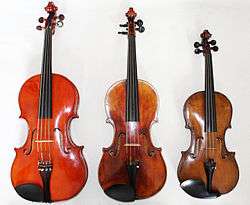Viola profonda
The viola profonda is a bowed string instrument in tenor-range, with four strings, which is bigger than a viola and its standard way of playing is resting on the shoulder (as a violin and viola).

By having its own sound colour and by filling the entire tenor-range, it reforms the usual classical string quartet and completes the idea of classical music theory of having four separate voices with their own timbre each (soprano, alto, tenor, bass) in every instrument-category; as known in the choir, the woodwinds and the brass family, whereas in the usual string quartet the tenor range is distributed between the viola and the cello.
Tuning
Its pitch is one octave below the violin and the strings are tuned as G2, D3, A3, E4.
The notation is either in G-clef (sounds one octave lower than written); or in C-clef (sounds one fourth lower than written).
History
The viola profonda was invented by the Bolivian composer, director and instrument-developer Gerardo Yañez; the unique specimen was patented in 2007.
It has been presented officially the first time on November 2, 2008 at the St. Thomas Church, Leipzig-Germany and on January 14, 2010 at the Berliner Philharmonie.
Compositions
2002
- "Ofrenda" (Contemplative Meditation) – viola Profonda solo – Gerardo Yañez.
2008
- "Elegiaco" – viola Profonda & Guitar – Carlo Domeniconi.
- "Prelude" – viola Profonda & Guitar – Carlé Costa.
- "Epitaph" – viola Profonda & Piano – Helmut Friedrich Fenzl.
- "Guantanamo" (Blues) – viola Profonda & Piano – Gerardo Yañez.
- "Der Titan" (Prelude) – viola Profonda solo – Gerardo Yañez.
2009
- "Mística 10" – viola Profonda & Piano – Alberto Villalpando.
2010
- viola Profonda, Piano & Bandoneón - Judith Brandenburg.
- "Toccata Camila"-viola Profonda & Piano – Miguel Bareilles.
- viola Profonda & String orchestra – Jorge Gustavo Mejia Medina.
- "Ven" - viola Profonda & Piano - Judith Brandenburg.
- 3 Duos (1. Erstarrung, 2. Erregung, 3. Erwartung) – viola Profonda & Piano – Helmut Barbe.
- viola Profonda & Orchestra – Miguel Bareilles.
- viola Profonda & Chamber orchestra – Udo Agnesens.
- "Soliloquy" – viola Profonda & Piano – Daniel Léo Simpson.
- viola Profonda & Piano - Jorge Gustavo Mejia Medina
- "Kotti" (Blues) – Reformed string quartet, Piano & Drums – Gerardo Yañez.
2011
- "Sarabana" - viola Profonda solo - Martin Raetz.
- "Suita Andalusi" - viola Profonda & Piano - Nikios Tsiachris.
- "Amor Éternel" (Chanson) - viola Profonda & Piano - Martin Raetz.
- "Berlin - My heaven, my hell" (Fuge) - Violoncello, viola Profonda, viola & violin (reformed string quartet) - Gerardo Yañez.
- "String Quartet with four movements" for Violoncello, viola Profonda, viola, violin (reformed string quartet) - Daniel Léo Simpson.
- "Kuwalkado" (Tango-Habanera) - viola Profonda, Accordion, Bass & Guitar - Martin Raetz.
- "Oriental nights" (Tango-Habanera) - viola Profonda & Guitar - Martin Raetz.
- "Adarel" - viola Profonda, String orchestra & Drums - Gerardo Yañez.
- "Los diálogos de Tunupa" - viola Profonda & String orchestra - Alberto Villalpando.
- Sonata for viola Profonda & Guitar - Nikos Tsiachris.